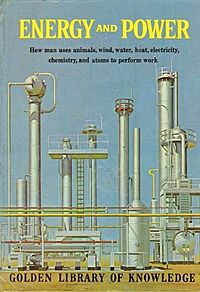Energy and Power facts for kids

Cover of Energy and Power
|
|
| Author | L. Sprague de Camp |
|---|---|
| Illustrator | Weimer Pursell and Fred Eng |
| Country | United States |
| Language | English |
| Subject | Science |
| Publisher | Golden Press |
|
Publication date
|
1962 |
| Media type | Print (Hardback) |
| Pages | 54 pp |
Energy and Power is a fascinating science book written for young people by L. Sprague de Camp. It was published in 1962 by Golden Press as part of The Golden Library of Knowledge Series. The book helps readers understand how humans use different sources of energy to do work. It has even been translated into Portuguese and Spanish, reaching more young readers around the world.
Contents
What is Energy and Power?
This book explores how we use energy and power in our daily lives. Energy is the ability to do work, and power is how fast that work gets done. From ancient times to modern days, humans have found clever ways to harness energy. The book covers many sources, including animals, wind, water, heat, electricity, chemistry, and even atoms. It shows how these different forms of energy help us build, move, and create.
Harnessing Animal Power
For thousands of years, humans relied on animals for their strength. Animals like horses, oxen, and donkeys helped with farming, transportation, and building. They pulled plows, carried goods, and turned grinding wheels. This was one of the earliest ways humans used living power to make work easier and faster. Even today, animals are still used for work in many parts of the world.
Wind: Nature's Gentle Giant
Wind has been a source of power for centuries. Early sailors used wind to push their ships across oceans. Windmills were invented to grind grain or pump water. These tall structures use large blades to catch the wind. As the blades turn, they power machinery inside. Today, giant wind turbines create clean electricity, helping to power our homes and cities.
Water: The Flow of Work
Moving water also holds a lot of energy. Waterwheels were common in the past, using the force of a river to turn machinery. They powered mills for grinding flour or sawmills for cutting wood. Today, we build large dams to create hydroelectric power. Water flows through turbines inside the dam, spinning them to generate electricity. This is another important source of clean energy.
Heat: From Fire to Engines
Heat is a very versatile form of energy. Early humans discovered fire, using it for warmth, cooking, and light. Later, people learned to use heat to power machines. Steam engines, for example, use heat to boil water and create steam. This steam then pushes pistons, making trains move or factories run. Modern power plants also use heat to create steam, which then spins turbines to generate electricity.
Electricity: The Invisible Force
Electricity is a powerful and widely used form of energy. It can be generated in many ways, including from burning coal, natural gas, or using renewable sources like solar, wind, and hydro. Electricity powers almost everything around us. It lights our homes, runs our computers, charges our phones, and operates our appliances. Understanding electricity is key to understanding modern life.
Chemistry: Energy in Reactions
Chemistry is all about how different substances interact. Chemical reactions can release or store energy. For example, burning wood is a chemical reaction that releases heat and light. Batteries use chemical reactions to create electricity. Our bodies also use chemical energy from food to move and think. The book likely explains how these reactions provide useful energy for various tasks.
Atoms: Unlocking Tiny Power
The energy within atoms is incredibly powerful. Nuclear power plants use a process called nuclear fission. This process splits atoms, releasing a huge amount of heat. This heat is then used to boil water and create steam, just like in other power plants. The steam spins turbines to generate electricity. While complex, atomic energy is a very concentrated source of power.
Why is Energy Important?
Energy is essential for almost everything we do. It allows us to travel, communicate, build, and even grow food. Without energy, our modern world would not exist. Learning about different energy sources helps us understand how our world works. It also helps us think about how we can use energy wisely and find new, cleaner ways to power our future.

